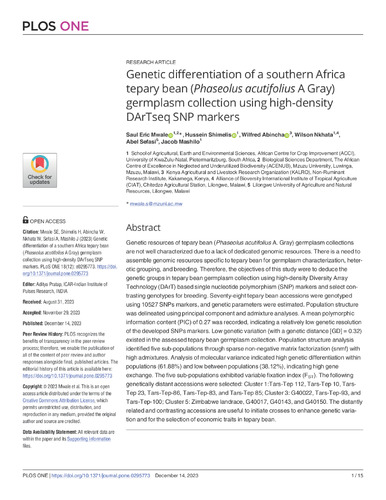Genetic differentiation of a southern Africa tepary bean (Phaseolus acutifolius A Gray) germplasm collection using high-density DArTseq SNP markers
Genetic resources of tepary bean (Phaseolus acutifolius A. Gray) germplasm collections are not well characterized due to a lack of dedicated genomic resources. There is a need to assemble genomic resources specific to tepary bean for germplasm characterization, heterotic grouping, and breeding. Therefore, the objectives of this study were to deduce the genetic groups in tepary bean germplasm collection using high-density Diversity Array Technology (DArT) based single nucleotide polymorphism (SNP) markers and select contrasting genotypes for breeding. Seventy-eight tepary bean accessions were genotyped using 10527 SNPs markers, and genetic parameters were estimated. Population structure was delineated using principal component and admixture analyses. A mean polymorphic information content (PIC) of 0.27 was recorded, indicating a relatively low genetic resolution of the developed SNPs markers. Low genetic variation (with a genetic distance [GD] = 0.32) existed in the assessed tepary bean germplasm collection. Population structure analysis identified five sub-populations through sparse non-negative matrix factorization (snmf) with high admixtures. Analysis of molecular variance indicated high genetic differentiation within populations (61.88%) and low between populations (38.12%), indicating high gene exchange. The five sub-populations exhibited variable fixation index (FST). The following genetically distant accessions were selected: Cluster 1:Tars-Tep 112, Tars-Tep 10, Tars-Tep 23, Tars-Tep-86, Tars-Tep-83, and Tars-Tep 85; Cluster 3: G40022, Tars-Tep-93, and Tars-Tep-100; Cluster 5: Zimbabwe landrace, G40017, G40143, and G40150. The distantly related and contrasting accessions are useful to initiate crosses to enhance genetic variation and for the selection of economic traits in tepary bean.

